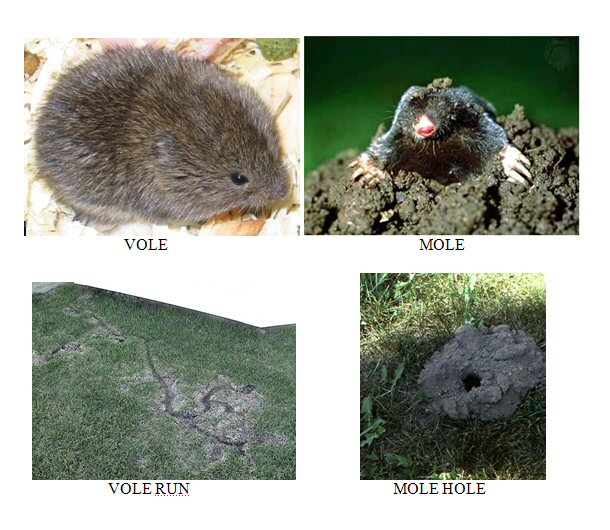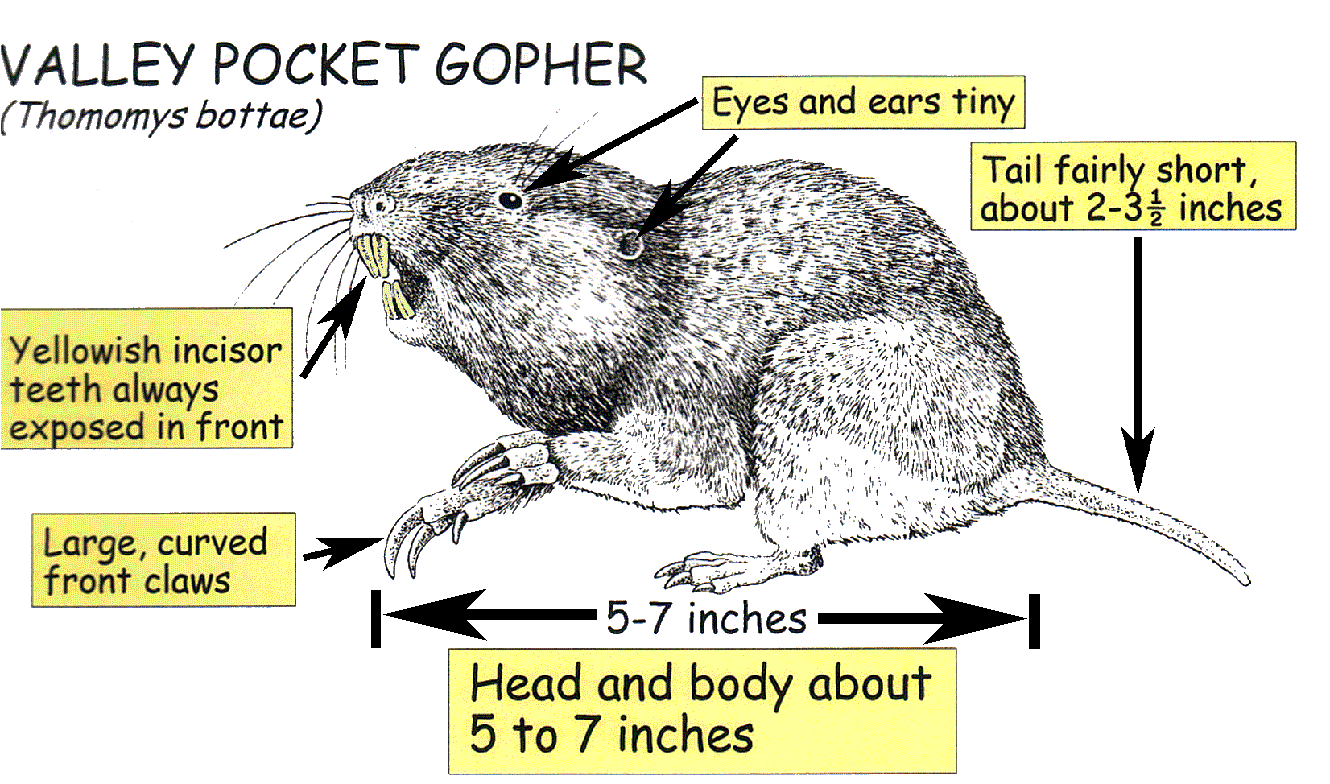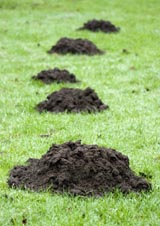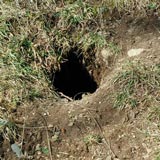Mole Vole and Gopher Removal Minneapolis and St Paul Minnesota
A number of rodents are known to burrow beneath the earth to build nests. Some construct elaborate tunnels through which they travel, while others live in simple, excavated holes in the ground. Among burrowing rodents are gophers, moles and voles. The burrowing habits of these rodents can cause considerable damage to your lawns and garden.
Most animals that are detrimental to your garden can be kept away with a simple fence. But there are those small, burrowing critters that just cannot be blocked. To get rid of an infestation of moles, voles, gophers or other burrowing varmints, you will need to destroy the existing population. Their destructive activity could cause concern to any lawn-loving Minnesotan.
Identify Your Pest
 Identifying the pest you’re trying to get rid of is key when you’re dealing with either gophers or moles.
Identifying the pest you’re trying to get rid of is key when you’re dealing with either gophers or moles.
Moles and pocket gophers are often found in the same location and their damage is often confused. Control methods differ for the two species. Moles leave volcano-shaped hills that are often made up of clods of soil. The mole hills are pushed up from the deep tunnels and may be 2 to 24 inches (5 to 60 cm) tall. The number of mole hills is not a measure of the number of moles in a given area. Surface tunnels or ridges are indicative of mole activity.
Gophers can pose a serious threat to your property. There are a lot of different types of gophers, but the pocket gopher is probably the gopher you’re trying to get rid of. Getting rid of gophers isn’t easy. Gophers are harder than heck to get rid of.
Moles remove many damaging insects and grubs from lawns and gardens. However, their burrowing habits disfigure lawns and parks, destroy flower beds, tear up the roots of grasses and create havoc and leaving your lawn or garden in shambles.
 Gophers use their forepaws and incisors to burrow into the earth. Herbivorous in nature, they are also inclined to uprooting and feeding upon plants. However, gophers are solitary rodents and rarely live within close proximity to one another. For this reason, they are considered less destructive than other burrowing rodents.
Gophers use their forepaws and incisors to burrow into the earth. Herbivorous in nature, they are also inclined to uprooting and feeding upon plants. However, gophers are solitary rodents and rarely live within close proximity to one another. For this reason, they are considered less destructive than other burrowing rodents.
 Pocket gopher mounds are generally kidney-shaped and made of finely sifted and cloddy soil. Generally, gophers leave larger mounds than moles do. Gopher mounds are often built in a line, indicative of a deeper tunnel system.
Pocket gopher mounds are generally kidney-shaped and made of finely sifted and cloddy soil. Generally, gophers leave larger mounds than moles do. Gopher mounds are often built in a line, indicative of a deeper tunnel system.
Moles and voles have similar names and appearance and they both damage yards in their different ways. However, they are quite different from mice and moles (which also tunnel underground). Voles are grayish-brown and about 5-6 inches long. Unlike the house mouse, voles have a blunt nose, short furry ears, and small eyes.
Voles live outdoors in shallow burrows in the soil; they feed on the roots and tubers of trees and plants, and can cause extensive damage to plantings and orchards. They are sometimes found in sheds and in basements, but do not naturally infest houses. Vole populations peak in natural cycles every few years, and during this time they can be very abundant. They prefer grassy areas or areas with heavy mulch and ground cover.
They travel in above ground runways and underground burrows. Moles dig in the soil and feed on worms, insects and grubs. Most moles don’t eat plants, but sometimes damage plants through tunneling activities. Voles eat bark, green plants and seeds. Preventing moles and voles from entering your yard involves removing their food sources or making these food sources inaccessible. Once they appear in your yard, traps can effectively control these pests.
Moles can be difficult to eliminate. There are many remedies out there – some valid and others just strange. One of the more effective professional methods is using a spike trap. It has spring loaded spikes that are placed over the surface tunnels. One of the best times to use them is when moles are highly active. Typically, during the fall after a rain is a sure bet.
Voles resemble mice in appearance and are sometimes referred to as field mice. Because voles are herbivorous and prefer to feed on seeds, tubers and green vegetation, their presence can prove destructive to agricultural communities. Voles also feed regularly on bark and have been known to kill saplings. Unlike most rodents, voles are active day and night. They reproduce quickly, leading to infestation.
 Gophers, moles and voles can have several litters in a season. If you do not want your yard overrun with dirt mounds and the dead damaged trails on your lawn all summer, it is best to address the pocket gopher, mole, or vole problem as soon as you notice activity. One way to detect whether or not mole tunnels are active (for moles that build shallow tunnels) is to find a straight runway and stomp it in with your foot. If the mole is active in that area they will repair the tunnel in no less than a day. Another way to find an active mole runway is to poke around with a stick around the area where there are a large number of molehills. Once you’ve found a spot where the earth gives way, you’ve found an active tunnel.
Gophers, moles and voles can have several litters in a season. If you do not want your yard overrun with dirt mounds and the dead damaged trails on your lawn all summer, it is best to address the pocket gopher, mole, or vole problem as soon as you notice activity. One way to detect whether or not mole tunnels are active (for moles that build shallow tunnels) is to find a straight runway and stomp it in with your foot. If the mole is active in that area they will repair the tunnel in no less than a day. Another way to find an active mole runway is to poke around with a stick around the area where there are a large number of molehills. Once you’ve found a spot where the earth gives way, you’ve found an active tunnel.
Remove Gophers, Moles or Voles From Your Home Minneapolis and St Paul Minnesota
Gophers, along with their little mole and vole friends, are more than just a nuisance. These small little rodents cause serious damage to lawns and landscaping. Although poisons are commercially available, they are toxic to humans and pets so care must be exercised with their use. THE ONLY WAY TO EFFECTIVELY CONTROL MOLES IS TO TRAP AND PHYSICALLY REMOVE THEM! Successful trapping requires time, patience, knowledge of mole habits and a thorough knowledge of the trapping equipment used.
So, which do YOU have: Moles, Voles or Gophers?
Rodents multiple swiftly and infestations may be extremely difficult to exterminate. It is advised that anyone experiencing a rodent infestation contact a Minnesota Wild Animal Management Expert for an inspection and consultation.
Remove Unwanted Gophers, Moles or Voles Minneapolis | Gopher, Mole & Mole Removal St Paul Minnesota




